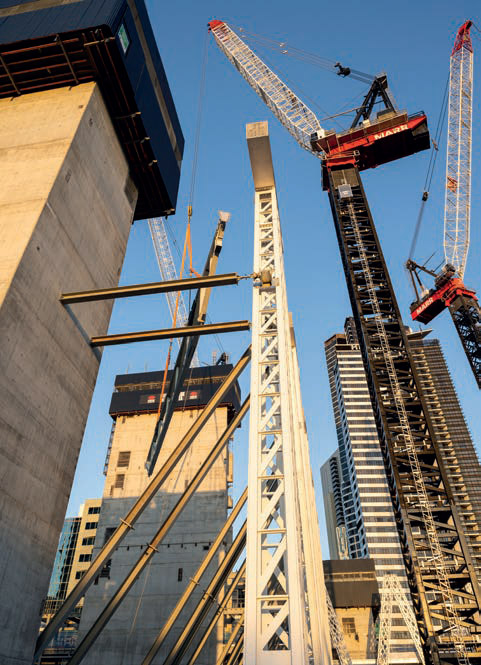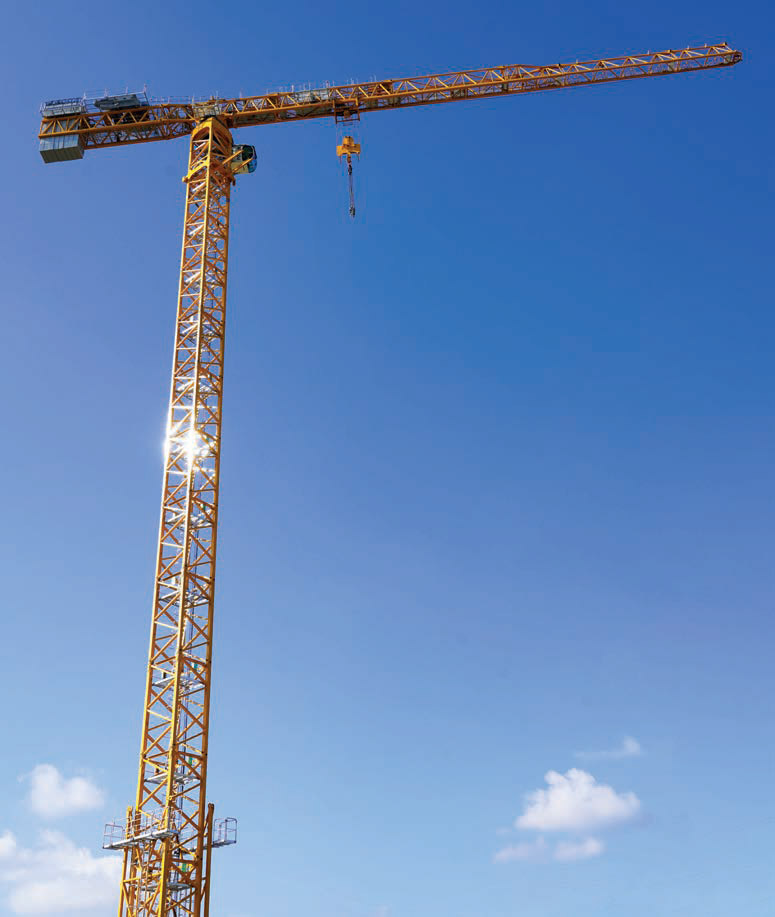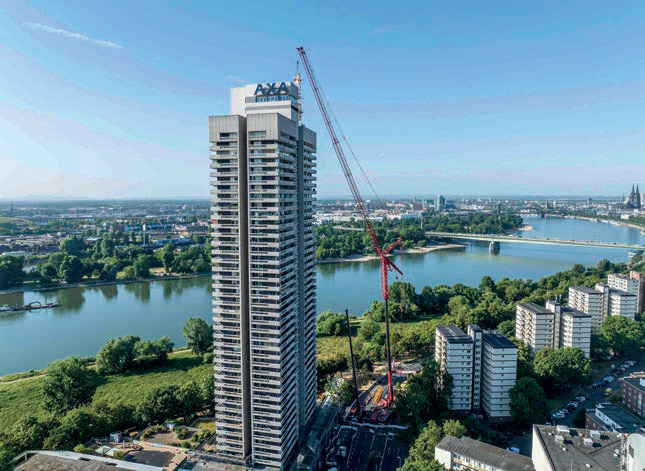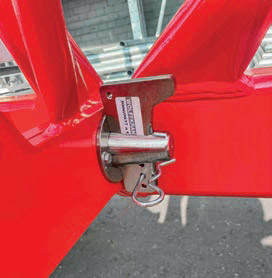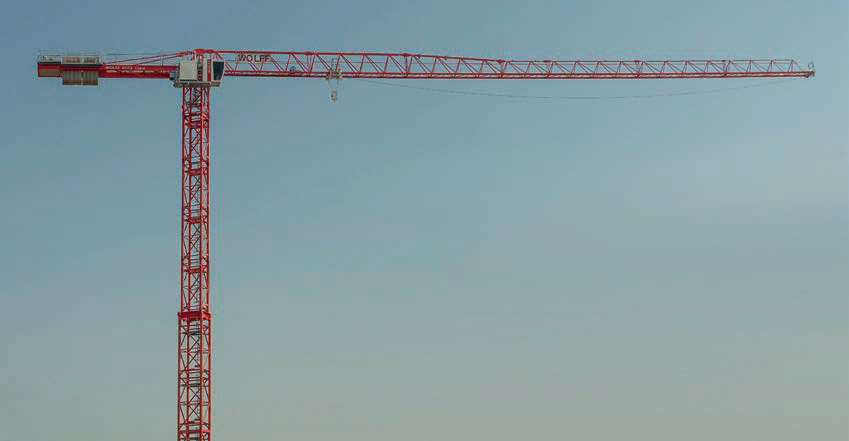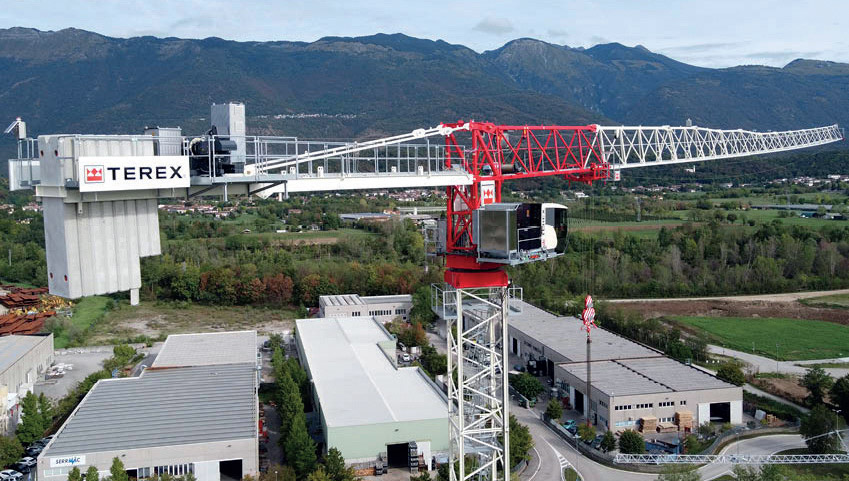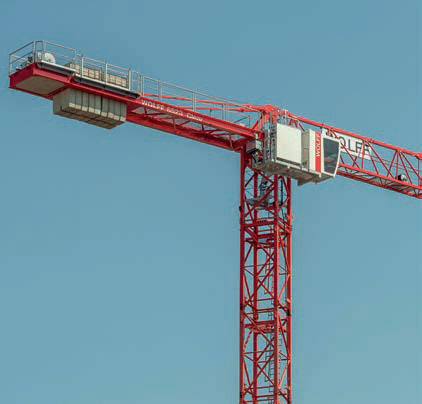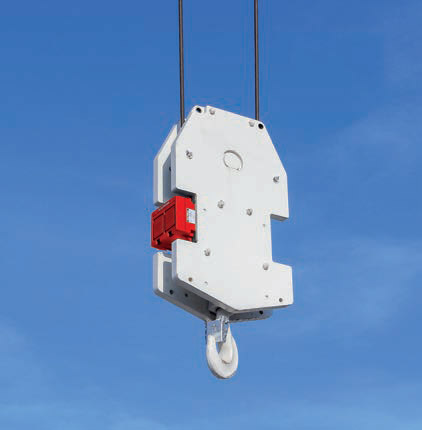Towering above
24 January 2024High-rise buildings need high-rise cranes. Julian Champkin looks at flat-tops and new designs of luffers.
Tower cranes are, on the face of it, a mature design; today's hammerheads and flat-tops look much the same in outline as those of 20 years ago. After all, if you are lifting a load up a high-rise, how can you improve on a vertical tower with a horizontal jib sticking out of the top?
But technology has advanced – digital technology especially – and is applied to new tower cranes as to other types. Some new models have intelligent control systems; some are additions to manufacturers’ ranges; one or two are just, well, bigger.
We start with Wolffkran, who added a new model this summer. The Wolff 6523 Clear is a flat-top in the 224 tonne class. It is based on Wolffkran’s 6031 Clear, one of the company’s best-selling cranes, but comes with a newly designed and patented jib.
The redesigned jib now has bottom chord connections that use bolts, and the jib sections, including the rope swivel traverse, are mounted on the front with a mandrel and wedge connection. In the top chord a change is that the pins are inserted into pear-shaped holes to make assembling it easier: it can now be done without using a hammer, says Wolffkran.
The machine is equipped with a 45 kw hoist winch. It lifts a maximum of 8.5 tonnes in two-fall operation with a jib length of 30 metres, and 12.5 tonnes in fourfall operation with a reach of 21.5 metres. At maximum jib length of 65 metres it has a tip load capacity of 2.3 tonnes in normal operation and 2.5 tonnes with the activated Wolff Boost function. The jib can be extended from 30 to 65 metres in 2.5 metre increments.
The crane comes with a combined UV 20/TV 20 tower connection which allows it to be mounted freestanding on a 2.0 x 2.0 metre tower of up to 69 metres. Using a 2.9 x 2.9 metre tower it can operate at 106 metres without tie-ins.
The Wolff 6523 Clear will primarily be sold in Germany (D), Austria (A), and Switzerland (CH) – hence the DACH region in sales parlance - although a version with a maximum payload of 10.5 tonnes in two-fall operation as well as an US version are being planned. The crane can also be specified with plastic fibre rope to replace the steel rope.
DIGITAL SOLUTIONS
We mentioned digital technology and controls; well, Woffkran is onto it. HiSPS stands for Wolff’s new High Speed Positioning System; it premiered it at Bauma 2022. It is available as an option on the 6523 and, from the beginning of 2024, on other new Wolff cranes; and existing Wolff cranes can also be retrofitted.
According to Wolffkran, HiSPS enables loads on the crane hook to be moved virtually sway-free and positioned with millimetre precision.
The system operates using two battery-powered sensors, one on the trolley and one on the block of the crane hook. Connected to a control unit in the switch cabinet, it detects the rope’s movements and automatically adjusts the motion and speed of the slewing gear and trolley to it. “Ultimately, the crane operator controls more than the crane – they control the load with assistance from the system,” says Viktor Mosolf, Head of the Digitalization Department at Wolffkran.
By activating the HiSPS, the load that was already swinging as a result of the crane movement is stopped within seconds. The system can also be used to eliminate heavy wind effects.
Since the trolley always assumes its position automatically via the hook block when HiSPS is activated, it prevents the load from being pulled diagonally: the trolley automatically moves so that it is always positioned precisely over the load when the hook is manually pulled or pushed by riggers on the ground.
“HiSPS significantly reduces the risk of accidents and damage due to swinging loads or hooks,” says Mosolf. “And the anti-collision system is optimised, since not only the crane but also the load in the working range limitation is automatically stopped.”
According to Wolffkran the HiSPS increases efficiency at the construction site as well as safety. Previously the crane operator had to move the load slowly to prevent a strong pendulum motion.
With the system connected, users can move the crane significantly faster. The HiSPS also allows hook positions to be saved and automatically moved to. As a result, the load can be positioned precisely even with a limited view.
Dr. Mohamed Abouelezz is Head of Product Management and Business Development at Wolffkran. “The crane movement and position data that HiSPS generates can be integrated into the modern digital construction site organisation using building information modelling,” he says.
“With HiSPS our cranes are ready for the progressive digitalisation of the building industry.” Wolffkran says it is also looking to make the high-speed positioning available for its luffing jib cranes too.
Remaining on the technology front, back in the summer of 2025 Wolffkran announced a global sales agreement with US-based Vita Industrial, maker of intelligent lifting systems and construction technology. The Vita Load Navigator (VLN) is a propulsion driven device that orients loads to eliminate spinning, rotations, swaying and other problems that can cause damage or injuries.
The system connects below the crane hook; it measures over 1,000 data points per second to detect load movement in real-time, and adjusts the load accordingly using high-powered fans to keep it in the desired orientation.
Incorporating the VLN system into crane operations will improve safety and efficiency, and will also lead to significant insurance savings to operators, says Vita, as the company is working with industry partners to design a formal insurance programme. First evidence of the co-operation is the purchase of ten VLN units to be integrated into Wolffkran’s rental and sales portfolio.
Terex also has a new flat-top: the CTT 292-12. It was released in January 2023 and is of 12 tonne maximum capacity with five metre jib steps from 25 to 70 metres.
This particular model extends Terex’s coverage of the 200/300 metre tonne class. So far it is proving to be competitive, says Terex; it claims impressive lifting capacity all along the jib. Its electronics also are state-of-the-art, with multi-function joysticks and a seven-inch touchscreen colour display. It can also run the Terex T-link telematics function, which sends remote crane data over the web, giving instant diagnostics, operating data, machine status, and other key metrics to the owner. Maintenance and service needs can therefore accurately be based on factory recommended usage rates and wear: users can be sent automated maintenance notices, reducing downtime and keeping the machine in prime running condition and extending lifespan.
SIZE MATTERS
We mentioned sheer size in our introduction. In April, Manitowoc announced the launch of the Potain MCT 1005 M50, the largest topless tower crane ever to be manufactured at its Zhangjiagang facility in China.
It follows hard on the heels of its MCT 1005, which itself was the company's largest model at its launch. It is designed for emerging markets and Southeast Asia and, boasting a huge 50 t capacity, the crane is available with three counterjib options that will further enhance its seamless integration into confined jobsites.
The MCT 1005 M50 allows for the handling of eight tonnes at the end of its 80-metre-maximum jib, which is configured from 11 sections of either 5 m or 10 m in length. Only three sections are required to deliver its shortest configuration of 20 m, at which distance it can lift its full 50 t.
The same maximum capacity is also available between 3.5 – 16.8 m when the jib is built to 80 m, or from 3.5 – 25.2 m when the jib is 30 m in length.
There is also the option of configuring the crane with the 45 m jib, which delivers a hefty 24.8 t maximum capacity at the jib end.
These heavy payloads are supported with counterjib options of 15 m for jib configurations of up to 45 m; 17.5 m for configurations of up to 55 m; and 20 m when working with jibs from 60 to 80 m. This versatility aids the crane’s ability to work in proximity to other cranes or nearby structures.
Over 1,070 m of rope is available on the drum; smooth and precise frequency drives on Potain’s 25 DVFC 25 trolley efficiently transport the crane’s payload horizontally. Slewing speeds are set at between 0 and 0.7 rpm via the RVF 174 Optima+ system.
The K850 mast, of 2.45 m x 2.45 m sections, gives a freestanding height under hook of up to 69.7 m. At the top is the V140S Vision cabin. The entire top-slewing section can be delivered to the jobsite in as few as 11 trucks, offering a surprising ease of transportability for such a large crane.
“As topless tower cranes continue to increase in popularity, we are quickly responding to the demands of our customers in Asia-Pacific for highercapacity models,” said Leong Kwong-Joon, regional product manager for tower cranes at Manitowoc. “Topless tower cranes are ideal for large infrastructure projects or modular developments and a host of other applications, and with the Potain MCT 1005 M50 we’ve created a model with a vast range of jib lengths and capacities that is capable of meeting almost every task demanded of it.”
The MCT 1005 M50 arrives on the market just over six months after the launch of the Potain MCT 805, which was previously the largest Zhangjiagang-produced topless Potain crane when it launched in April 2022.
NEW SHAPES
We said at the start that hammerhead and flat-top tower cranes have hardly changed in basic design. This is perhaps not so true of luffers. In those there is still room for new shapes and concepts, and several manufacturers have been at work on precisely that.
One of them is ENG in Italy: its new hydraulic ETH luffer does not have a counter-jib. This, the company says, makes it unique. Without a counter-jib it takes up minimal room on a construction site which, of course, allows more efficient operations in tight spaces.
The genesis of the design, says ENG, is its experience in building derrick cranes, used for disassembling internal climbing cranes on high-rises under construction; its hydraulic luffer is based on the same crane.
The ETH series comes in four capacities, from 8t to 16t, with jib lengths up to 60m.
ENG also has its EDL series of hybrid cranes that can work as both a fixed-jib and as a luffer.
They have a flat mode, as normal, but the operator can change at will to a luffing mode. The range is also unusual in having a double counterweight: they work in tandem, and are claimed to give extra stability. The latest model in the range is the 16t EDL 230 which has 60 m of jib.
Spanish-based Comansa has two new models in its luffing crane range: the LCL 560, of 36 tonne capacity, and the LCL 800, a 50 or 64 tonne capacity machine. The LCL 560 is fully compatible with the existing D35 and D36B tower structures; the LCL 800 uses the D36B structure.
They both have a new 132-kilowatt hoist mechanism and a half fall system for high lifting speeds. A new feature is an extra auxiliary mechanism for the fast installation of ropes. The two cranes join the company’s LCH300/16t hydraulic luffer introduced in October 2022, which has a novel luffing system in which jib and counter jib are moved at the same time by a hydraulic cylinder at the cathead/jib hinge assembly.
The modular jib of the LCH300 has a reach of 25 to 60 metres, with configurations every five metres.
The minimum working radius is four metres and the minimum radius when out of service is nine metres. This is an important aspect to take into account in places with limited space, which, as Comansa point out, is what luffing jib cranes are designed for. The new LCL560 and LCL800 models also have a reduced out of service radius.
And Comansa, like the other manufacturers mentioned, has its own digital solutions. Crane Mate, presented at Bauma in 2022, is for fleet management. The hardware part of it is a complete kit that is pre-installed in the cranes in turnkey mode and is made up of commercial devices, which makes any replacements, maintenance, and retrofitting easier. The software is a platform developed in-house by Comansa for online access. It displays the machine’s settings, functions, and other services required by the user, and gives comprehensive crane fleet management. This includes: analysis and verification of hours worked; constant supervision of errors and alarms; real time technical information on location, alerts, crane productivity and maintenance parameters; personalised data reports; and ad-hoc integration with third party information technology platforms.
This all leads to enhanced productivity, reduction in operating and service costs, extended life of the crane and general maximisation of fleet efficiency, profitability and safety, according to the company.
Raimondi flat-tops for prestige Toronto high-rise development
Canadian builder Avenue Building Corporation deployed a Raimondi LR273 luffing crane for a new residential high-rise in Toronto. 55 Charles Condo is located in the city’s sophisticated Bloor Yorkville area.
“The Raimondi LR273 is one of the best-selling models for this type of development in Canada, especially in major metropolises like Toronto. High-rise buildings are in increasing demand and swing rights are an issue; making this crane an asset,” said Jim Patullo, President, Avenue Building Corporation.
“The out of service radius and the ease of its internal climbing allow us to install the luffer on several ‘zero lot line’ projects,” he added.
Located in a congested area, surrounded by several other highrise developments, the 18 tonne maximum lifting capacity crane was installed in February 2021 and is at work with a 40 metre jib, clocking in at 15m out of service radius with a tip load of 8.20t in UltraLift.
Erected on a 6 GR6L tower sections on a concrete pad in the below ground parking at level 4, the 36m tower height has been climbed internally for the past two years until reaching the final height of 167m above the ground level. Sitting now on the roof, the LR273 is approaching the fi nal stages of the project, with the expected dismantling date scheduled for December 2023.
“Another asset of this luffer is the ability to promptly switch from two falls to four falls and reverse, allowing to lift large generators, air handling units, BMUs, and more without any downtime. It has 86kW hoisting gear, can lift at a maximum speed of 204 metres per minute and has a drum capacity of 980m, which gives excellent lifting performances and helps meet site deadlines,” he said, adding that the weight-optimised luffer is also very easy to assemble and boasts excellent load curves.
“Our fleet currently counts seven Raimondi cranes, all deployed across different sites in Toronto, and we are pleased to anticipate that two additional LR273 luffing jib cranes will shortly go up in another key development of the city.”
Marr installs 120 tonne modularised sections in single lifts
In Australia, Powerhouse Parramatta, currently being constructed by Lendlease on behalf of the NSW Government, will be the largest museum in NSW at 30,000 square metres, with more than 18,000 square metres of exhibition and public space including Australia’s largest column-free exhibition space. Designed so that its exterior superstructure is a celebrated architectural feature, the museum’s two buildings feature three types of steel lattices as an exoskeleton.
With the structural support for the trusses that achieve the column-free exhibition space sitting on the exterior of the building, the challenge from a construction point of view was how to install the heavy steel trusses and deliver the project to the architectural team’s vision. Lendlease engaged heavy lift tower crane specialists Marr Contracting during the planning stage.
Marr’s solution was to install three Heavy Lift Luffi ng (HLL) tower cranes including a 330-tonne capacity Favelle Favco M2480D, a 150-tonne capacity M1280D and a 96-tonne capacity M860D. By allowing bigger, heavier modularised sections of the exoskeleton including steel trusses weighing up to 120 tonnes to be installed in a single lift, the cranage methodology will reduce the number of lifts required and decongest the site.
According to Marr’s Design & Engineering Manager, Andrew Coffin, “From an engineering standpoint this project is a significant challenge due to its complexity. The key was understanding the desired approach to building the project and designing the crane solution around that idea.”
“It took vision, innovation and collaboration to design a cranage solution that will deliver this amazing project” said Marr’s managing director, Simon Marr, “It’s a great example of achieving a better solution for the project team by asking ‘how do you want to build the project?’ and designing the cranage solution around a construction methodology instead of construction being driven by the limitations of the crane as we are constantly seeing in other parts of the world.”
With sustainability sitting at the heart of the building and its construction, Powerhouse Parramatta will be Parramatta’s first public 6 Star Green Star Building. It is also one of the first projects in Australia to use 100% renewable diesel (HVO100) in Marr’s cranes working on the project.
Powerhouse Parramatta is expected to be completed in late 2024.
Liebherr LTM 1750-9.1 aids renovation of iconic high-rise in Cologne
Once a showcase project and, at the planning stage, even Europe’s tallest residential building the 45-storey Axa high-rise on the banks of the river Rhine in Cologne was completed in 1973 and provides accommodation for around 1,000 people. As the building’s exposed aggregate concrete balconies have been dilapidated for some time, they are now being removed and replaced. An LTM 1750-9.1 and, as an auxiliary crane, an LTM 1150-5.3 were brought in to prepare the work site.
Today, the 147-metre high-rise is a listed building. This has made the renovation of its balconies a challenge, as noticeable changes to the building’s appearance are not permitted. To install the new, more weather-resistant balconies made of glass and aluminium, two tower cranes were mounted on the building’s roof last summer. An LTM 1750-9.1 mobile played a key role in this project, using its 52-metre telescopic boom as well as a 15-metre mast extension and a 91-metre luffi ng jib to rise various parts of the two Liebherr tower cranes.
“We used the entire ballast of 204 tonnes as well as all available equipment for the mobile crane for this operation,” reports Christian Kühne, project manager at the crane company Colonia. Thanks to its Y-guying system, considerable load increases can be achieved by combining the crane’s high lifting capacities with the variable jib system, Liebherr claims.
The large crane was supported by an LTM 1150-5.3, which was used as an auxiliary and assembly crane on the ground.
The cranes were used in tandem for one week on the banks of the Rhine in Cologne.
The 750-tonne crane was set up in under two days. “With a maximum hook height of 152 metres, a building height of 147 metres and a load capacity of 13.4 tonnes, the constellation for this operation was impressive,” says Kühne.
